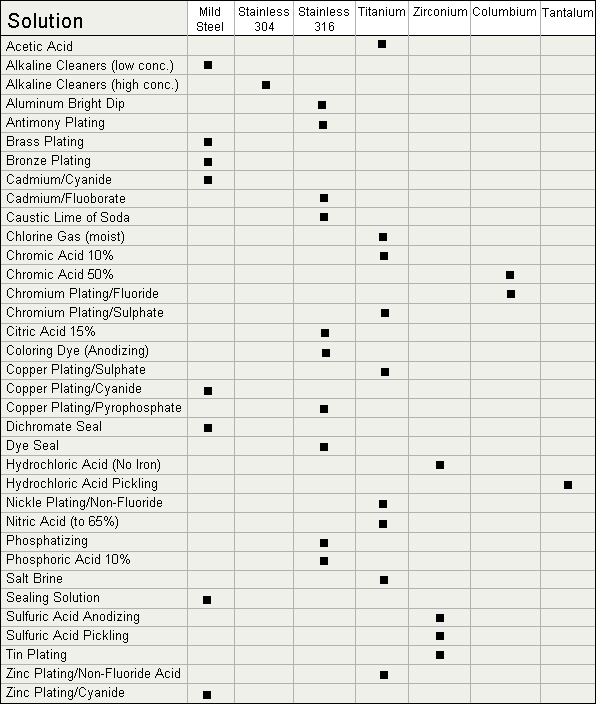Material Selection
The proper material selection for your SX-2 Coil is of utmost importance. This selection will help you to determine whether your coil will stand-up to a
Corrosive Environment, on how long the coil will effectively function, on how frequently they will have to be repaired, etc.
Click here to see important notes on corrosion and ways to reduce it.
The table below provides general guidelines on what coil material should be used in different chemical solutions. However, due to the ever-increasing amounts of proprietary chemical solutions being offered by chemical suppliers, we suggest you contact your chemical supplier and follow their coil material recommendation. Please read this
important disclaimer.
Special Notes On Corrosion - Ferric or cupric chlorides and/or fluorides in sulfuric acid pickling solutions will greatly accelerate the corrosion of Zirconium. After exposure to acids and other corrosive solutions,
ZIRCONIUM must be handled with extreme caution. Sharp contact with metal or ground, or exposure to humid air can cause violent burning of the surface film. To neutralize after exposure, treat immediately in hot air or steam for one hour at 250 degrees Centigrade.
We have found that many coils, despite proper material selection, showed signs of premature and sometimes serious corrosion. Analysis revealed that
GALVANIC CORROSION was the reason for the premature failure of these coils.
Galvanic corrosion occurs when two dissimilar metals are submerged in a liquid capable of carrying electric current.
Sometimes galvanic corrosion can be controlled by installing electric insulation between the heating/cooling coil and other metal parts present in the tank, especially tank walls. Stray currents can also be responsible for galvanic corrosion. Stray currents may enter the tank through metallic tank walls, floors and piping. Always use di-electric couplings. They may also occur when a coil is too closely positioned to the anode.
If these problems occur or are being anticipated, MBA will be glad to assist you in developing a satisfactory solution.
Disclaimer - Material suggested on this web site provide general guidelines only. This table should only be used as a general guideline and these suggestions do not constitute a guarantee of coil material corrosion resistance. In view of the ever increasing amounts of proprietary chemical solutions being offered by chemical suppliers, we suggest that you contact your chemical supplier and follow their recommendation in selecting the most suitable material for your specific application.
|


